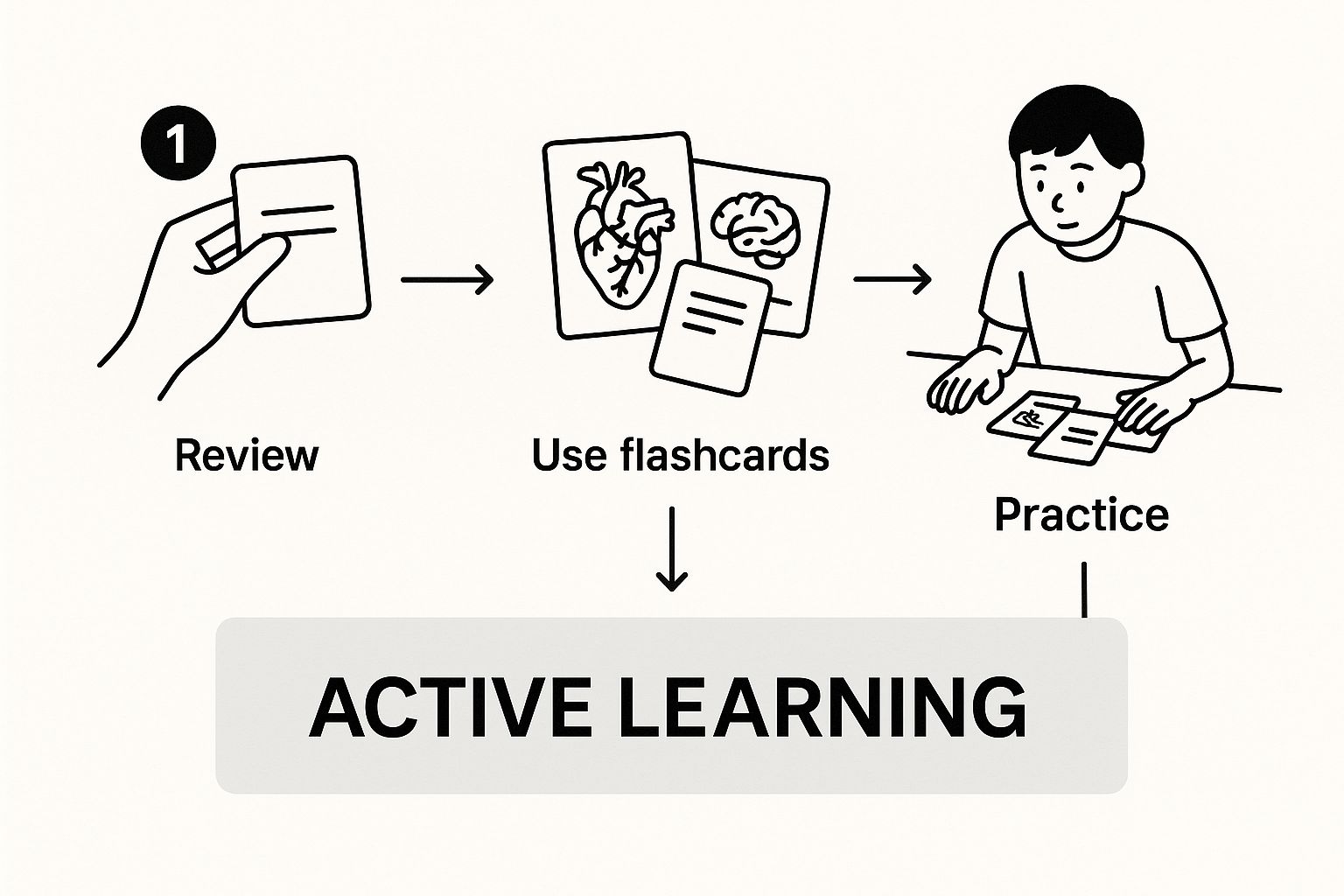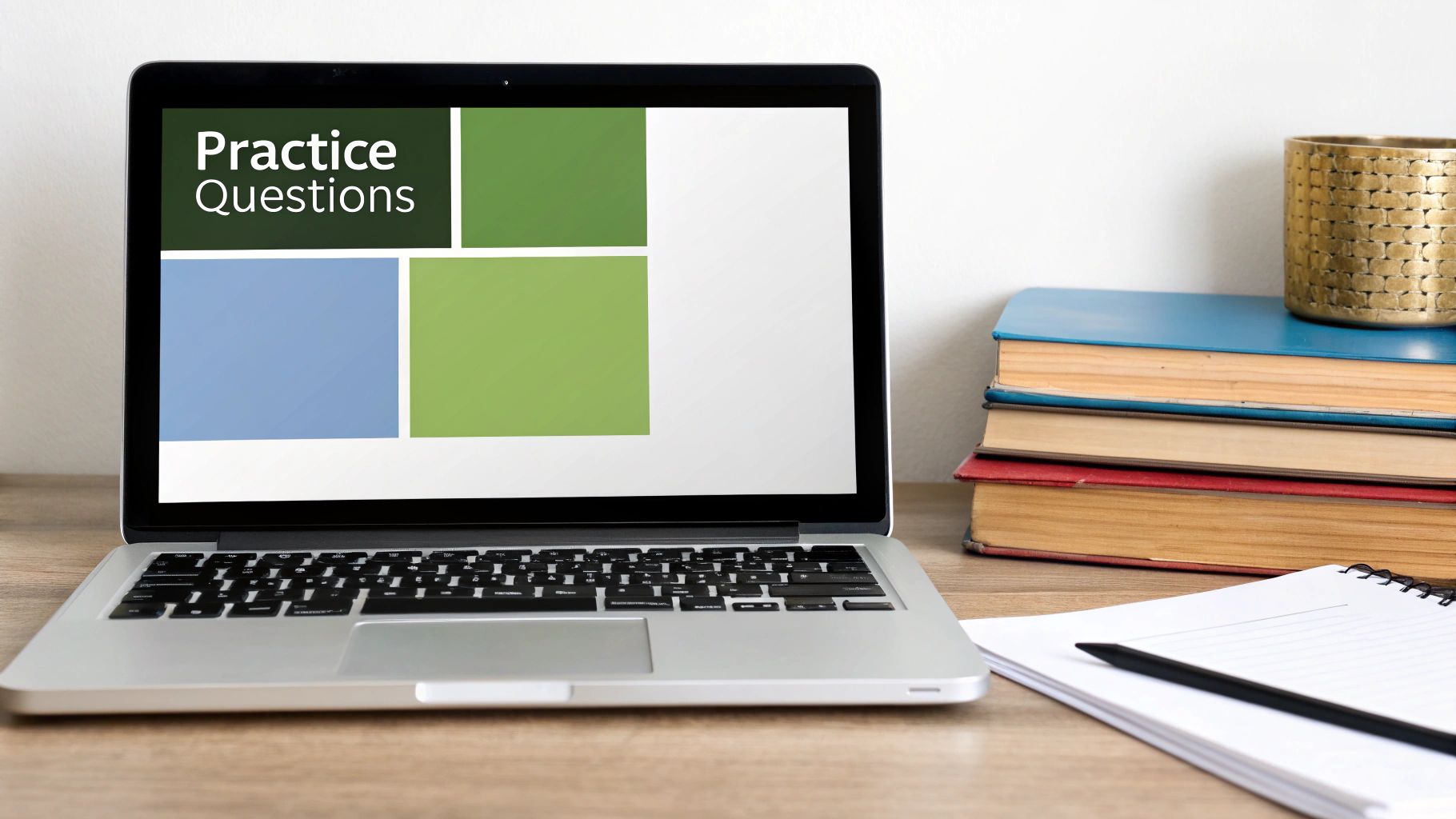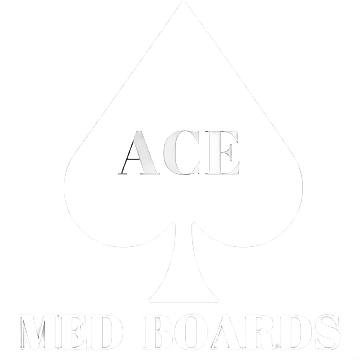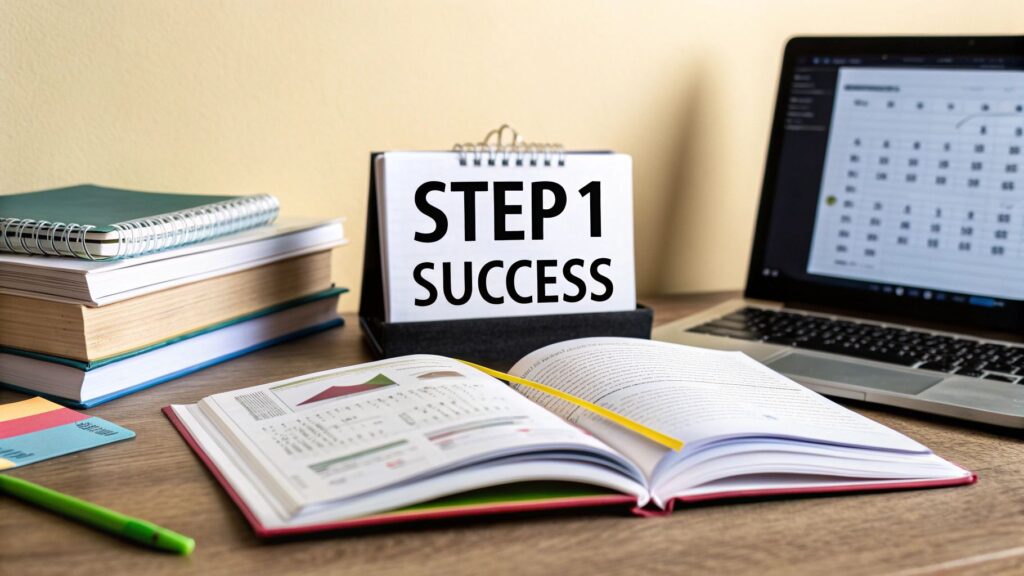A solid USMLE Step 1 study plan is the single most important tool in your arsenal. The best approach breaks your prep into two distinct phases: a foundational pre-dedicated period during your first two years of med school and an intensive dedicated period right before the exam.
Thinking about it this way ensures you master the material without burning out. It’s not just about passing; it’s about building a rock-solid knowledge base for your entire medical career.
Why a Strategic Step 1 Plan Matters Now More Than Ever

With Step 1 now a pass/fail exam, it’s tempting to think the pressure is off. But the reality on the ground is quite different. The shift didn't make the exam any easier—it just changed what "success" looks like. A "pass" is now the bare minimum, and just hoping you'll clear that bar is a risky bet for your residency prospects.
The New Reality of Pass/Fail
When the scoring system changed to pass/fail in January 2022, the board also made a subtle but critical adjustment: they raised the minimum passing score from 194 to 196. This small bump, coupled with an increasingly competitive field of test-takers, led to a slight increase in failure rates.
What does this mean for you? It means that a structured, intentional study plan is more critical than ever. You can dig into the full report on these scoring shifts to get a better sense of the current landscape.
Key Takeaway: With a pass/fail Step 1, residency programs place even more weight on other parts of your application, like your Step 2 CK score, research, and letters of recommendation. A Step 1 failure becomes a major red flag, making a first-time pass absolutely essential.
The Two Core Study Phases
A winning study plan is really built on two interconnected periods: the pre-dedicated phase and the dedicated phase. Think of them not as separate sprints, but as two legs of the same marathon. Your performance in the first leg directly sets you up for success in the second.
To give you a clearer picture, here’s how these two phases break down.
USMLE Step 1 Study Phases At a Glance
| Study Phase | Typical Duration | Primary Goal |
|---|---|---|
| Pre-Dedicated Phase | 1.5 – 2 years (M1/M2 years) | Build a strong, integrated knowledge base alongside your regular coursework. |
| Dedicated Phase | 4 – 8 weeks | Consolidate all knowledge, master test-taking strategies, and peak for exam day. |
A disorganized approach during your M1 and M2 years almost always leads to panic and cramming later—a recipe for falling short. On the other hand, a thoughtful plan from day one builds the confidence and competence you need to walk in and pass. This guide will give you the framework to build that plan, starting with a solid foundation.
Building Your Pre-Dedicated Foundation
Your success in the dedicated study period is almost entirely decided by the work you put in before it even starts. Those first two years of medical school? That’s not just coursework; it’s your launchpad.
Think of it this way: the pre-dedicated phase is for methodically laying down a strong, integrated knowledge base. If you treat your standard curriculum as continuous Step 1 prep, you’ll hit dedicated ready for high-level review, not a frantic scramble to learn two years of medicine from scratch.
The secret is to start seeing your classes through a Step 1 lens from day one. Every lecture, every lab, every organ system block is a chance to lock in high-yield concepts. This mindset shift prevents that overwhelming feeling of facing a mountain of material you have to re-learn in just a few weeks.
Weaving In High-Yield Resources Early
Don't let your essential Step 1 resources gather dust until dedicated. The real magic happens when you integrate them slowly and consistently throughout your M1 and M2 years. This builds familiarity and creates much deeper, stickier knowledge.
Treat First Aid less like a textbook to be read cover-to-cover and more like a living atlas for your curriculum. As you cover cardiology in class, spend that same week reading the cardiology section in First Aid. This immediately shows you what the exam writers consider most important, helping you filter and focus your learning.
Likewise, you should start using a question bank like UWorld or Amboss way earlier than you probably think. You don't need to do full, 40-question timed blocks. That's not the goal here. Instead, use it as a powerful learning tool. After a week on renal physiology, just do 10-15 renal questions in tutor mode. This forces you to actively recall information and, crucially, see how those foundational concepts are actually tested in a clinical context.
Structuring Your Pre-Dedicated Weeks
Burnout is the enemy of long-term success. The key is to build a sustainable schedule that values consistency over raw intensity. You're trying to create habits that make Step 1 review feel like a natural part of your weekly rhythm.
Here’s what a manageable weekly workflow might look like:
- The Weekend Preview: Spend an hour or two on Sunday glancing over the upcoming week's topics. A quick skim of the relevant chapters in First Aid primes your brain, making your lectures feel more like a review than a first pass.
- The Daily Anki Grind: Make Anki a non-negotiable daily habit. Seriously. Whether it's 30 or 60 minutes, commit to clearing your review queue and making new cards from your classes and any practice questions you tackle.
- End-of-Week Consolidation: On Friday or Saturday, cap off the week with a small, targeted set of practice questions (15-20) covering that week’s material. The most important part? Meticulously review every question—right or wrong—and turn any weak points into new Anki cards.
Pro Tip: Align your Anki deck with your school's curriculum. As you start a new organ system block like pulmonology, go into a pre-made deck (the AnKing deck is the gold standard) and "unsuspend" the cards for that specific system. This ensures your daily spaced repetition is directly reinforcing what you're learning in real-time.
Prioritizing Subjects by Exam Weight
Let’s be honest: not all subjects are created equal on Step 1. While you absolutely have to master your school’s curriculum to pass your classes, it’s just smart strategy to give a little extra love to the most heavily tested disciplines. This is a critical component of any effective USMLE study plan for Step 1.
Think of it in tiers:
- Tier 1 (The "Big Three"): Pathology, Pharmacology, and Physiology. These three form the absolute backbone of the exam. You'll find them integrated into nearly every single question.
- Tier 2 (Major Systems & Foundations): Microbiology, Biochemistry, and Immunology. These are foundational disciplines that are tested heavily and frequently.
- Tier 3 (Lower Yield but Essential): Anatomy, Embryology, Histology, and Behavioral Science. You absolutely need to know this stuff, but the concepts often carry less weight per question compared to the big three.
Understanding this hierarchy helps you make intelligent decisions about your most limited resource: time. It means spending that extra hour truly mastering the pharmacology and pathology of a system, because that knowledge will pay the biggest dividends on test day.
Walking into your dedicated block with this kind of solid, prioritized foundation is the single most powerful thing you can do to set yourself up for a pass.
Crafting Your Dedicated Study Schedule
This is it—the final, intensive push. Your dedicated study period is where all that foundational knowledge gets sharpened into a high-performance tool for test day. Think of it as a full-time job, typically lasting between four and eight weeks, where your only goal is to consolidate, review, and master the material needed to pass Step 1.
A successful dedicated period hinges on a well-structured daily and weekly schedule. It's all about finding a rhythm that maximizes your efficiency while sidestepping the burnout that can derail even the most prepared students. Forget those myths about 16-hour study marathons; the real goal is smart, sustainable effort.
Designing Your Daily Blueprint
Your daily schedule is the micro-level execution of your broader USMLE study plan for Step 1. While everyone’s personal rhythm is different, a highly effective model involves breaking your day into distinct, manageable chunks. This approach prevents mental fatigue and keeps you laser-focused.
A proven method is to use two or three major study blocks, each centered on a specific task. For example, your morning could be dedicated to new content and practice questions, while the afternoon is reserved for a deep, meticulous review of those questions and shoring up any weak areas you've identified.
Here’s a sample daily structure you can adapt to fit your style:
- Morning Block (8 AM – 12 PM):
- Hour 1: Warm up with Anki reviews. This gets your brain firing and activates previously learned concepts.
- Hours 2-4: Dive into two 40-question UWorld blocks under timed conditions. You have to simulate the real exam environment.
- Afternoon Block (1 PM – 5 PM):
- Hours 1-4: This is the most critical part of your day. Meticulously review every single question from your morning blocks. You need to understand why the right answer is right, but just as importantly, why the wrong answers are wrong. What concept was the question really testing?
- Evening (6 PM – 8 PM):
- Wind down with some light content review, focusing on a specific topic you flagged as a weakness earlier.
- Make new Anki cards for concepts you struggled with to ensure you see them again.
Critically, you must schedule your breaks. A real lunch break away from your desk, short walks between blocks, and a hard stop time in the evening are not luxuries—they are absolutely essential for maintaining your cognitive stamina over several weeks.
This infographic really drives home how to integrate the active learning techniques that should be the core of every single study block.

The image reinforces a key principle for your dedicated period: you have to move beyond just passively reading and watching videos. Your time is better spent actively engaging with the material through things like flashcards and drawing out diagrams.
Building Your Weekly Systems-Based Attack
With a daily template in hand, you can zoom out to structure your weeks. From my experience, the most effective method is a systems-based approach. Dedicate a few days to a major organ system—like Cardiology or Renal—allowing you to dive deep and truly see the connections between its physiology, pathology, and pharmacology.
But while you're focusing on one system, you absolutely must be integrating other foundational sciences. For instance, during your "Cardiology" days, you should also be reviewing related microbiology (think infective endocarditis) and pharmacology (like antiarrhythmics and antihypertensives). This interwoven approach mirrors the interdisciplinary nature of the actual Step 1 exam.
Here's a sample table showing how you might structure a 6-week dedicated period, focusing on a new system each week while constantly reviewing others.
Sample 6-Week Dedicated Study Block
Use this template to organize your dedicated study period by subject, integrating consistent review and practice testing.
| Week | Primary System Focus | Integrated Review Topics | Key Assessment Goal |
|---|---|---|---|
| 1 | Cardiology | Embryology, Biochemistry, General Pharmacology | Baseline NBME at the end of the week |
| 2 | Pulmonology | Microbiology, Immunology, Relevant Pathophysiology | Review weak areas from first NBME |
| 3 | Renal & Endocrine | Physiology, Histology, Related Pharmacology | Mid-point NBME to track progress |
| 4 | GI & Reproductive | Anatomy, Pathology, Biostatistics | Focus review on lowest-scoring subjects |
| 5 | Neurology & MSK | Neuroanatomy, Behavioral Science, Genetics | UWorld Self-Assessment 1 (UWSA1) |
| 6 | Hematology/Oncology | All high-yield weaknesses, rapid review | Free 120 and UWSA2 for final simulation |
Remember, your USMLE study plan isn't set in stone. It has to be a living document that you adjust based on cold, hard performance data. This is where your assessments come in.
Integrating NBME Assessments to Steer the Ship
Official NBME (National Board of Medical Examiners) self-assessments are your primary diagnostic tools. They give you the most accurate prediction of your performance and, more importantly, highlight your specific weaknesses with undeniable data.
Don't make the mistake of saving these for the very end. A strategic schedule for these exams is vital to your success.
- Get a Baseline. Take one NBME either before your dedicated period begins or in the first few days. This gives you an honest, unfiltered starting point and helps shape your initial study focus.
- Schedule Mid-Point Check-ins. Plan to take an NBME every 1-2 weeks throughout your dedicated block. This regular feedback loop is crucial. It lets you track your progress and make real-time adjustments to your study plan. If your scores in endocrinology are lagging, you can allocate more time to it the following week.
- Do a Final Dress Rehearsal. In your final week, take one of the UWorld Self-Assessments (UWSAs) or the Free 120 offered by the NBME. These are fantastic for simulating the length and feel of the real exam, helping you build that crucial test-day stamina and confidence.
After every single assessment, dedicate at least half a day to an exhaustive review. Don't just glance at the score. You need to analyze every incorrect question to understand the "why" behind your mistake and turn those insights into actionable study points for the week ahead.
Choosing and Integrating Your Study Resources

The market for Step 1 resources is a crowded, noisy space. It's incredibly easy to get paralyzed by choice or, even worse, fall into the "resource overload" trap. This is where you try to use everything and end up mastering nothing.
From my experience, a successful usmle study plan step 1 is built on a lean, powerful toolkit—not an entire library. You need to be selective and strategic.
The Core Four Framework
The most effective approach I've seen is committing to a "Core Four" framework. This gives you a complete, integrated system without the clutter and confusion of juggling a dozen different sources. Everything else is just supplemental.
Your entire preparation should revolve around four key resource types. Mastering these will give you a massive edge over students who spread their attention too thinly.
- A Premier QBank: This is your primary tool for active learning. A top-tier question bank like UWorld is non-negotiable.
- A Central Content Review Book: You need a single, high-yield source of truth. For almost every student, this is First Aid for the USMLE Step 1.
- A Spaced Repetition System: Anki is the gold standard for a reason. It automates the process of reviewing information at the perfect interval to lock it into your long-term memory.
- Official Practice Exams: The NBME self-assessments are your reality checks. They provide the most accurate measure of your progress and readiness for the real thing.
Seriously, resist the temptation to keep adding more resources. Your goal is deep mastery of a few elite tools, not a superficial pass over many.
Turning UWorld Into Your Primary Textbook
One of the biggest mistakes I see students make is treating their QBank like a simple testing tool. UWorld isn't just for assessment; it's your most important learning resource. Its explanations are incredibly detailed and high-yield, often containing more practical, clinically-oriented information than standard textbooks.
You need to shift your mindset. Every 40-question block isn't a test—it's a guided lesson on 40 high-yield topics. The real work isn't just seeing what you got wrong. It's about extracting the core educational objective from every single question, including the ones you answered correctly.
Expert Tip: Create a dedicated notebook or digital document for your UWorld reviews. For each incorrect question, write down a single, concise sentence summarizing the main learning point you missed. This active process of summarizing forces comprehension and creates a personalized "weakness log" to review.
Making First Aid Your Personal Exam Bible
Out of the box, First Aid is an excellent but dense reference book. Your job is to transform it into a personalized, annotated guide that reflects your unique learning journey. The key is to annotate it with information you learn directly from your QBank.
As you review your UWorld blocks, have First Aid open to the relevant section. When you find a concept in a UWorld explanation that isn't in First Aid—or is explained in a way that finally makes it click—add a brief note in the margin of your book. This process turns First Aid into a dynamic, customized textbook that grows with your understanding.
If you're looking for digital tools to help organize your notes and materials, you can explore tnote.ai for platforms designed for this purpose.
Integrating Videos Without Passive Learning
Video resources like Pathoma and Boards and Beyond are fantastic for building an initial understanding of a topic. However, they can easily become a passive learning trap. Let's be clear: just watching a video is not the same as studying.
To use videos strategically, follow this simple process:
- Prime Before Questions: Watch a video on a topic before you tackle a block of questions on that subject.
- Annotate Actively: As you watch, have First Aid open and add notes on key points, just like you do with your QBank review.
- Never Just Watch: Immediately follow up any video session with a set of practice questions on that topic to actively recall and solidify the information.
This approach ensures you are always engaging with the material, not just consuming it. Even with the exam now pass/fail, this level of focused preparation is vital. While about 90% of students still pass on their first try, this represents a slight dip from previous years. A rigorous, active study plan is the best way to ensure you're in that passing group.
For more detailed guidance on integrating these tools, check out our complete breakdown on how to study for USMLE Step 1.
Crushing Question Banks and Nailing Self-Assessments
Let’s be blunt: active recall through practice questions is the single most important thing you can do to prepare for Step 1. Your entire usmle study plan step 1 needs to be built around this reality. This isn't about passively letting information wash over you from a textbook or video. It's about actively, sometimes painfully, digging facts out of your brain under pressure—which is exactly what the real exam will feel like.
One of the most common and dangerous myths is thinking you can pass just by re-reading First Aid or binge-watching video lectures. That's a recipe for disaster. The heart and soul of your dedicated study period, and a huge chunk of your time before that, must be spent doing and then meticulously reviewing practice questions. This is where the real learning—and the score jumps—actually happen.
The Art of the UWorld Block Review
Flying through a 40-question block just to see your percentage correct is a colossal waste of time. The magic isn't in doing the questions; it's in the deep-dive review that comes after. Your mission is to squeeze every last drop of educational value out of every single question, whether you aced it or bombed it.
A quick, superficial review might take 30 minutes. An effective review, the kind that actually moves your score, should take 2 to 4 hours. Yes, for one 40-question block. It’s a serious time investment, but the return on that investment is enormous.
The real purpose of a QBank isn't just to test you. It's to teach you what you don't know and, crucially, how the exam writers test those concepts. Every single question is a mini-lesson on a high-yield topic.
So, what does a high-impact review actually look like? It’s a structured, almost forensic, process.
- Read the Punchline First: Before you do anything else, scroll to the bottom of the explanation and read the "Educational Objective." This one sentence is gold—it tells you the exact concept the question was designed to test.
- Figure Out Why You Messed Up: For every wrong answer, diagnose the root cause. Was it a straight-up knowledge gap? Did you misread a critical word in the question stem? Or did you get suckered in by a beautifully crafted distractor? Be honest with yourself.
- Dissect Every Single Answer Choice: This is non-negotiable. For every question, you have to understand why the right answer is right and why every other option is dead wrong. This simple habit turns one learning point into four or five.
- Tie it Back to Your Core Resource: Have First Aid open right next to UWorld. Find the topic. Did the question bring up a detail that wasn't in FA? Scribble in a quick note. Is the UWorld diagram clearer? Make a reference. You are actively building your own personalized, high-yield study guide.
- Make a Targeted Anki Card: If you missed a concept or learned something new, turn it into a focused Anki card on the spot. Don't just copy-paste. Phrase it as a question that forces you to recall the specific piece of information you were missing.
Using Self-Assessments as Your Personal Roadmap
NBME Self-Assessments and the UWorld Self-Assessments (UWSAs) are far more than just score predictors. Think of them as powerful diagnostic tools, like a CT scan for your knowledge base. They give you a data-driven map that points directly to your weaknesses. Taking one and not reviewing it properly is like ordering an expensive lab test and then throwing the results in the trash.
When you take one, you need to simulate test day with almost paranoid strictness.
- The full eight hours, with scheduled breaks.
- No phone. No interruptions. No peeking at notes.
- Start it at the same time your real exam is scheduled to begin.
This grueling process builds the mental and physical stamina you’ll need for the real marathon. But once you hit "submit," the most important work begins. Your score report is a treasure map. If "Endocrine" is your lowest-scoring section, guess what you're focusing on for the next week? It removes all the guesswork.
This focused approach is absolutely critical. The data on pass rates tells a stark story. While first-time takers from US/Canadian schools do very well, the road is much harder for those who have to repeat the exam. In 2021, the pass rate for repeat takers was only 66% for MD students and a shocking 45% for international medical graduates. You can dig into the numbers yourself by exploring the complete USMLE performance data. This isn't meant to scare you; it's meant to underscore the absolute necessity of having a rock-solid plan to get this done right the first time.
Protecting Your Mental Health and Avoiding Burnout
The intense pressure of building the perfect usmle study plan step 1 often completely overshadows something just as critical for your success: your mental and physical endurance.
Let’s be real. Step 1 prep is a marathon, not a sprint. You have to treat it that way from day one if you want to avoid the burnout that sidelines countless smart, hardworking students every single year.
Your well-being isn't a luxury you can afford after you study; it’s a core component of an effective plan. This means you need to schedule your downtime with the same seriousness you schedule your UWorld blocks. It’s not about being lazy—it’s about being smart.
Recognizing the Early Warning Signs
Burnout doesn't just show up one day unannounced. It’s more like a slow creep of exhaustion, cynicism, and a gnawing feeling that nothing you do is effective. Spotting the early signs is your best bet for getting back on track before you completely derail.
Keep an eye out for these common red flags:
- Persistent Fatigue: You feel bone-tired even after a full night's sleep.
- Loss of Motivation: The thought of opening First Aid makes you want to crawl back into bed.
- Irritability and Cynicism: You find yourself snapping at friends or feeling completely detached from why you started this journey.
- Declining Performance: Your practice scores are stagnating or even dropping, no matter how many more hours you cram in.
If any of this sounds familiar, it's not a sign of weakness. It's a signal that your strategy isn't working for you anymore. To protect yourself, it's vital to adopt proven strategies for preventing burnout, which are surprisingly similar to what professionals use in other high-stakes fields.
Building Resilience Into Your Schedule
The absolute best way to fight burnout is to stop it before it even starts. This means building a sustainable routine that values recovery just as much as it values hard work. Your brain consolidates memories and truly learns when it's rested, not when it's running on fumes.
You are not a machine. A study plan that ignores the need for sleep, exercise, and social connection is a plan designed for failure. Prioritizing these elements is one of the highest-yield activities you can do.
You need to bake these non-negotiables into your weekly schedule:
- Protected Time Off: Schedule at least one half-day or, even better, a full day off each week. This means zero studying. No Anki reviews. No "quick" videos. Absolutely nothing.
- Daily Movement: Even a 20-minute walk outside can make a huge difference in your focus and stress levels. Don't sacrifice it for another 20 minutes of reading a dense chapter.
- Consistent Sleep: This is not optional. Aim for 7-8 hours of quality sleep every night. It’s when your brain actually does the hard work of consolidating everything you learned.
- Maintain Connections: Make time for a quick call with a friend or family member who gets it. Having a strong support system is key to keeping your perspective when you're deep in the study trenches.
Ultimately, understanding the mental toll this exam takes is a massive part of the battle. For a deeper look at this topic, check out our insights on managing USMLE exam burnout and staying resilient through it all.
Of course. Here is the rewritten section, crafted to sound like it was written by an experienced human expert, following all your specified requirements.
Answering Your Biggest Step 1 Study Plan Questions
When you’re mapping out your USMLE study plan for Step 1, it’s the nitty-gritty details that often cause the most stress. I’ve seen hundreds of students grapple with the same practical questions. Let's clear up some of the most common ones so you can move forward with confidence.
How Many Practice Questions Should I Do Per Day?
This is easily the question I get asked most, and the honest answer is: it depends entirely on where you are in your prep.
Before your dedicated study period, think of questions as a tool for reinforcement. Squeezing in 10-20 targeted questions a day is a fantastic way to solidify what you’re learning in class without hitting a wall. It’s about quality, not quantity, at this stage.
Once dedicated hits, however, you have to ramp things up. The goal is to build stamina and pattern recognition. I’ve found the sweet spot for most students is 80-120 questions per day, usually done in two or three 40-question blocks. This volume is less about seeing every single fact and more about exposing your weaknesses so you can fix them.
Just remember, mindlessly cranking through questions is useless. The real learning happens in the review.
Should I Do My UWorld Blocks Timed or in Tutor Mode?
The best approach is a strategic mix of both—they serve completely different purposes.
Tutor Mode: This is your learning tool. Use it early on, especially when you’re just starting a new system. Getting instant feedback after each question is incredibly powerful for cementing new concepts. I recommend using it heavily in your pre-dedicated phase or the first week or so of dedicated.
Timed Mode: This is your training tool. As your test date gets closer, you absolutely must switch to timed mode. It’s the only way to simulate the real pressure of the exam and get your pacing down. During the bulk of your dedicated period, at least 80% of your practice blocks should be timed and random to mimic the real deal.
What's a Good Score on an NBME Practice Exam?
With Step 1 now pass/fail, the game has changed. You're no longer chasing a massive three-digit score. The goal is to be safely and confidently above the passing line, which is a score of 196.
My advice has always been to aim for a score of 210 or higher on at least two consecutive NBME practice exams before you sit for the real thing. This isn't about bragging rights; it's about building a comfortable buffer zone. Historically, students hitting this benchmark have a pass probability well over 95%.
Seeing those scores consistently does wonders for your confidence. It turns your practice tests from a source of anxiety into a reliable signal that you're ready. For more strategies on how to break down your scores and focus your efforts, you can check out these actionable medical exam study tips.
Feeling overwhelmed or need help turning your weaknesses into strengths? The expert tutors at Ace Med Boards provide personalized one-on-one guidance to build a USMLE study plan that works for you. Get the targeted support you need by visiting https://acemedboards.com to schedule your free consultation today.

